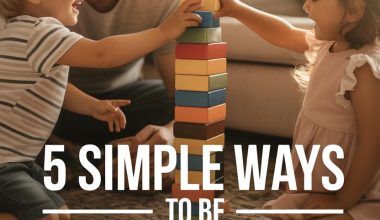Parental calm: the elusive unicorn. Just when you think you’ve got a handle on things, your child dissolves into a puddle of tears because you cut their toast into squares instead of triangles.
Or they’re suddenly overcome with injustice at the injustice of bedtime, broccoli, or the wrong-coloured cup.
The quickest way to lose your cool? A small person entirely losing theirs.
Is it possible to keep your head while your child is flailing, wailing, or negotiating like a pint-sized hostage negotiator? Absolutely.
Will you always get it right? Absolutely not.
But you can steady yourself and help your child steady themselves, too. Here’s how.
Catching Yourself Before the Spiral
Your child is red-faced, shrieking about the injustice of the universe. You feel your own blood pressure tick up, your jaw clench, your inner monologue suddenly less Mr Rogers and more Gordon Ramsay.
The trick is catching your own stress response before it hijacks your brain. When the chaos ramps up, try pausing for a literal breath.
One slow inhale, slow exhale. Not only will this help you avoid saying something you’ll regret (“Why are you like this?!”), it also models self-control for your child.
Researchers have found that parents’ emotional regulation strongly influences how children manage their own feelings. So, when you start to feel your calm slip, picture an invisible pause button.
Take a moment, even if it’s just to stare at the ceiling and count the cobwebs.
Your Tone Is Everything
It’s a cruel twist—children in meltdown mode seem to have antennae tuned to parental tone. Your child is already in emotional overdrive.
If your voice goes up an octave, gets louder, or drips with sarcasm, you’re likely to fuel their fire.
Aim for calm, low, and slow. This isn’t the time for a Shakespearean monologue about healthy emotional expression—save that for the car.
Just make sure your tone says, “I’m here, I’m steady, I can handle this.”
And if your voice quivers or you accidentally let slip a “For heaven’s sake!” don’t panic. Apologise if needed, and try again. Kids remember the repair more than the wobble.
Physical Tricks for Staying Cool
You don’t need fancy gadgets or a Himalayan salt lamp. A few simple moves can dial down your frazzled nerves:
- Drop your shoulders. Tension loves to camp out up there.
- Unclench your jaw. (No, really—check right now.)
- If you can, ground your feet firmly and plant yourself. Imagine you’re rooted, like a tree, while the storm swirls around you.
Some parents swear by squeezing a stress ball or massaging the fleshy spot between thumb and finger.
Others mentally recite football scores, song lyrics, or their favourite take-away menu. Anything neutral that distracts your brain from rising panic does the trick.
Don’t Take It Personally
Children are not small adults with questionable negotiation skills. Their brains are still a work in progress, especially the part responsible for emotional control.
When your child is losing it, chances are it’s not about you. Even if they announce—with theatrical flair—“You’re the worst parent ever!” (Congratulations, you’re officially a member of The Club.)
Their behaviour is a reflection of their own internal storm, not your parenting résumé.
It helps to remind yourself, “This is not about me. My job is to be the grown-up.” Even on days when you’d rather be the one lying on the floor, yelling about toast.
Empathy Over Explanation
Logic rarely wins against a child in meltdown. Explaining that “the blue cup is in the dishwasher” will not be met with reasoned acceptance.
Appealing to empathy, on the other hand, works wonders.
Try something like, “You’re really upset about the cup. It’s hard when things don’t go the way you want.” No need to fix, debate, or explain away their feelings.
Just acknowledging them can start to calm the storm.
Psychologists call this “emotion coaching,” and it helps children learn to understand and manage their own emotions as they grow.
It’s not about giving in—it’s about being a safe harbour while they ride out the waves.
Lower the Stakes
Sometimes our own stress gets tangled up in the moment. Maybe you’re late for work, or neighbours can hear the shrieks through the wall, or you’re worried the tantrum means you’re raising a future reality TV contestant.
Try zooming out. Will this cup/bedtime/broccoli battle matter in five years? Probably not.
Lowering the emotional stakes helps you find perspective—and keeps you from matching your child’s volume.
Have an Exit Plan
Not every situation allows for graceful exits, but whenever possible, give yourself permission to step away if your child is safe.
A quick trip to the loo, a moment outside to inhale something that isn’t the smell of frustration, or simply turning your back for a few seconds can work wonders. It’s not abandonment; it’s self-preservation.
If your child is old enough to be left alone for a minute, let them know: “I need a quick breather. I’ll be back in a moment.”
Even narrating your own coping—“I’m feeling frustrated, so I’m going to take a breath”—teaches more than any lecture.
Pick Your Battles
Some moments require firm boundaries (crossing streets, biting siblings, any incident involving Legos and bare feet). Other times, it’s okay to let small stuff slide.
Ask yourself: Is this about my values, or just convenience? Must the socks match? Is now the time for a life lesson, or just surviving until bedtime?
No parent wins every battle. The art lies in knowing which ones to fight and which ones to wave through with a weary smile and an extra episode of Bluey.
Keep Tools in Your Pocket
Preparation beats panic every time. A few strategies to have at the ready:
- Keep a “calm corner” or quiet spot in your home for both you and your child. Sometimes, a change of scene is all that’s needed.
- Carry a small comfort item, snack, or fidget toy when out and about.
- Use simple mantras, like “This too shall pass” or “I can handle this.”
- Download a mindfulness app designed for busy parents, like Headspace or Smiling Mind, for quick guided breathing when you need it most.
The more tools you have, the less likely you are to reach for the nearest chocolate bar or an extra glass of wine (no judgement, just solidarity).
Embrace Imperfection
No one expects superhero-level calm all the time. Every parent loses it occasionally. Perfection is not the goal—connection is.
If you do snap, circle back when things are calm. A simple “I got upset earlier—I’m sorry.
Everyone gets overwhelmed sometimes” does wonders for your relationship and shows your child how to bounce back from mistakes.
Research shows that repairing after conflict is more important for emotional security than never having conflict at all. So, every wobble is really just a chance to model resilience (see, silver linings everywhere).
Try a Little Humour
When all else fails, a sprinkle of humour can break the tension.
Your child is mid-meltdown over dropped cheese? Channel your inner David Attenborough: “Here we see the wild six-year-old, mourning the tragic fate of her grated cheddar…”
Humour doesn’t dismiss their feelings. It just reminds everyone (including you) that even sticky moments can be a bit absurd. Laughing together—eventually—makes the world feel lighter.
When to Seek Help
Some children struggle more than others with big feelings. If meltdowns are constant, extreme, or disrupt family life day after day, there’s no shame in asking for extra support.
Reach out to a paediatrician or family therapist if you’re concerned. Early intervention can make a world of difference, for both your child and your own well-being.
Because Calm Is Contagious
Children learn how to handle big feelings by watching how their grown-ups do it.
Every time you pause, breathe, and weather the storm—even if you’re faking it until you make it—you’re teaching your child that feelings are safe, and that there’s always a way through.
The next time you see a parent in the supermarket calmly cradling a shrieking toddler, give them a nod of respect—they’re doing Olympic-level parenting.
And when it’s your turn? You’ll have a few tricks up your sleeve, a deep breath at the ready, and the knowledge that keeping your cool is as much about caring for yourself as it is about caring for your little one.
Tea, anyone?





